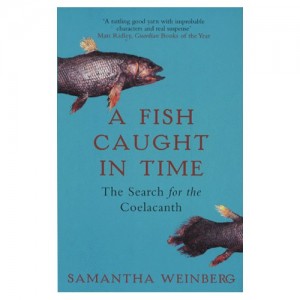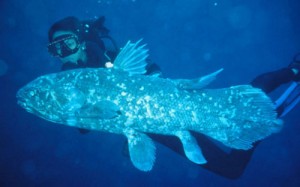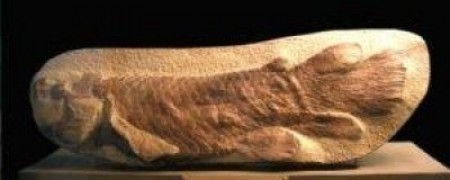A Fish Caught in Time: The Search for the Coelacanth by Samantha Weinberg
Rating: 




This is the modern history of the discovery of living Coelacanths (pronounced ‘seel-uh-kanths’). Since there have been exciting developments since 1998, it serves as a background text well worth reading especially for the human side of the story, the personalities involved, also a record of the petty exploitation and destruction these unique creatures have suffered since their rediscovery. Samantha Weinberg details the circumstances that led up to their protected status.
well worth reading especially for the human side of the story, the personalities involved, also a record of the petty exploitation and destruction these unique creatures have suffered since their rediscovery. Samantha Weinberg details the circumstances that led up to their protected status.
A few days before Christmas in 1938, a Coelacanth was caught at the mouth of the Chalumna River on the east coast of South Africa. The fish was caught by Captain Goosen and his crew, who had no idea of the significance of their find. They thought the fish was unusual enough to alert the curator of the local museum in the small South African town of East London, Marjorie Courtenay-Latimer.
She almost didn’t make the trek down to the docks because it was hot and she was busy. It was fortunate she did. She saw the strange blue fish and, as she said later, declared it was “the most beautiful fish I had ever seen…” She bought the animal and proceeded to take it back with her. After an argument with a cabbie who didn’t want to take the smelly carcass in his taxi, Courtenay-Latimer got it to the museum. However, once she was there she had no refrigeration facilities in which to keep such a large specimen and neither the local cold-storage warehouse nor the mortuary would cooperate. Turning to a local taxidermist, she had the animal and its viscera preserved as best she could. Then she wrote to J L B Smith telling him the story and including a sketch of the unusual animal. Smith was a South African chemistry professor who had taught himself ichthyology..
Smith was at his vacation home in Knysna when the letter arrived. The letter, sketch included, sent his mind reeling. He knew exactly what type of fish it was based on the description. It was about two metres in lengh. It was a coelacanth , a member of a group of fish called the Crossopterygii. The only problem with this conclusion was that the coelacanth and the Crossopterygii had gone extinct some sixty-five million years before along with the dinosaurs. The new specimen was hailed as a ‘living fossil’.
This Coelacanth specimen caught in 1938 led to the discovery of the first documented population, off the Comoros Islands, between Africa and Madagascar. For sixty years this was presumed to be the only Coelacanth population in existence.
Coelacanths are quite different from all other living fishes. They have an extra lobe on the tail, paired lobed fins, and a vertebral column that is not fully developed. Coelacanths are the only living animals to have a fully functional intercranial joint, which is a division separating the ear and brain from the nasal organs and eye. The intercranial joint allows the front part of the head to be lifted when the fish is feeding. One of the most interesting features of the Coelacanth, is that it has paired fins which move in a unique fashion. These aid it in seeking food, by remaining head-down, vertically above the sea-bed.
In April 2001, a female Coelacanth was caught off the coast of Kenya. The fish was 1.7 metres long and weighed 77 kilograms. The coelacanth was identified by its three-lobed tail and blue colour with white dots.
Female coelacanths do not lay eggs that hatch in water. Instead, they are ovoviviparous—producing eggs that develop and hatch within the female’s body or immediately after extrusion. Seventeen such eggs—each the size of a tennis ball—were retrieved from the female caught that year.
Coelacanths were considered the “missing link” between the fish and the earliest four-limbed land animals, until the first living specimen was found. Living coelacanths turned out to have no lungs. This discovery 65 million years after they were believed to have gone extinct makes them arguably the most well-known example of a ‘Lazarus taxon’, a species that appeared to have disappeared from the fossil record only to reappear much later. Since 1938, Coelacanths have been found in the Comoros, Indonesia, and elsewhere.
In 1998 a Coelacanth was caught in Sulawesi, Indonesia. The only obvious difference between it and the Coelacanth from the Comoros Islands was the colour. The Comoros Coelacanth is renowned for its steel blue colour, whereas fish from the Sulawesi population were reported to be brown. In 1999 the Sulawesi Coelacanth was described as a new species, Latimeria menadoensis.
How could Coelacanths disappear for over 80 million years and then turn up alive and well in the twentieth century? The answer favoured by evolutionists is that the Coelacanths from the fossil record lived in environments favouring fossilisation. Modern Coelacanths, both in the Comoros and Sulawesi were found in environments that do not favour fossil formation. They inhabit caves and overhangs in near vertical marine reefs, at about 200 m depth, off newly formed volcanic islands.
Is there real logic in confidently ascribing vast ages to fossil remains only for modern counterparts to exist all along?
Today there is a growing consensus among evolutionary biologists who have studied living specimens that Coelacanths are not missing links,” says The Washington Post. The Post cites the British journal Nature, indicating that the “Coelacanth features putatively linking it to land animals are probably only coincidentally similar. . . ..”
If the Coelacanth exists, isn’t it possible that other crypto-zoological creatures such as the Loch Ness Monster or the Canadian Ogo-Pogo may in fact be prehistoric animals said to have been extinct for millions of years?
See also: www.dinofish.com/ and www.seasky.org/deep-sea/coelacanth
